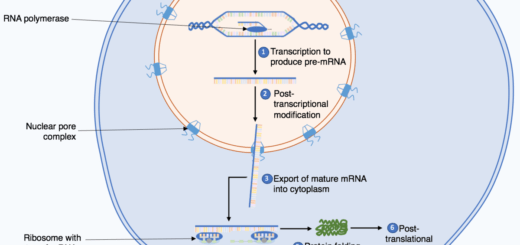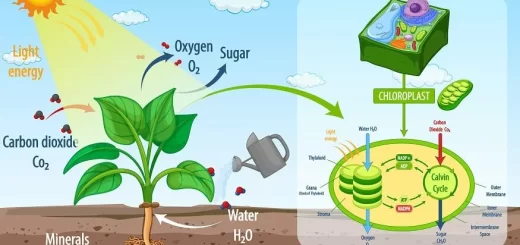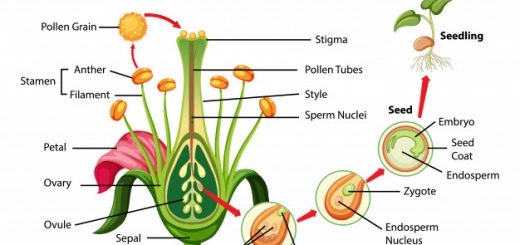Human immune system, Functions and Structure of the lymphatic system in human
Some organs of the immune system are called lymphoid organs because they are home to lymphocytes which are the main components of the lymphatic system, The parts of the immune system are scattered throughout the body, which means its parts are not linked to each other in anatomical succession, as that in (digestive system, respiratory system or circulatory system), but they interact and cooperate in a harmonious coordinated manner, so, the organs of the immune system functionally act as one unit.
Structure of the lymphatic system in human
First: Lymphoid organs
They contain large numbers of lymphocytes, Maturation and differentiation of lymphocytes take place in them, From the important lymphoid organs:
Bone marrow
Function: the production of red blood cells, white blood cells and blood platelets.
Site: a tissue found inside:
- The flat bones, such as the Clavicle, Sternum, Skull, Vertebral column, Ribs, Shoulder, and Pelvis.
- Heads of the long bones as that of femur, tibia and humerus.
Thymus gland
Site: located on the trachea above the heart and behind the sternum bone.
Function: secretes the thymosin hormone that stimulates the maturity of lymphoid stem cells to T-cells and their differentiation into different types inside the thymus gland.
Tonsils
They are two specialized lymphoid glands, They are located on both sides of the rear portion of the mouth, They pick up any microbe or foreign body that may enter with food or air and prevent its entry into the body, so, they work to protect the body.
Spleen
It is a small lymphoid organ, its size is not more than the fist and its colour is dark red, It is located in the upper left side of the abdominal, It plays an important role in the body’s immunity since it has a lot of:
- Macrophages: they are specialized white blood cells which pick up all that is strange about the body , whether microbes, foreign bodies or senescent somatic cells as that of senescent red blood cells and disintegrate them to their components to be disposed by the body, in addition to some of them carry the information which are collected about the microbes and foreign bodies to offer them for specialized immune cells.
- Lymphocytes: they are the other type of white blood cells that release special proteins in the blood known as antibodies that hold the mission of defense, where they defend the body against germs and viruses.
Peyer’s patches
They are small lymphoid cells that accumulate in the form of masses or aggregations, They spread in the mucous membrane lining the lower part of the small intestine, their full function is unknown, but they play a role in the immune response against the pathogenic microorganisms that enter the intestine and cause the diseases.
Lymph nodes
Their size ranges from a pinhead to the seed of small beans, They present along with the network of lymphatic vessels that located in all the body parts, as:
- Under the armpits.
- At the two sides of the neck.
- In the upper thigh.
- Near the internal body organs.
The node is divided internally into pockets filled with:
- B-lymphocytes.
- T-lymphocytes.
- Macrophages and other types of white blood cells that get rid of germs and the debris of cells.
Each lymph node is connected with several lymphatic vessels that transfer the lymph from the tissue to the nodes to filterate the lymph and get rid of the suspended foreign pathogen away from the body, They purify the lymph from any harmful substances or microbes, They store the white blood cells (lymphocytes) that help in fighting against any disease or infection.
Second: Lymphocytes
They from about 20: 30 % of the white blood cells in the blood, All lymphocytes are formed in the red bone marrow, At the beginning, they do not have any immune ability, but they pass in the process of maturation and differentiation in the lymphoid organs, after that they change into cells that have the ability of immunization.
They revolve in the blood to search for any microbe or foreign body, using their defence and immune mechanisms to get rid of the pathogenic microbes that try to invade the body, reproduce and spread in it, sabotage its tissues and disruption of its vital physiological functions, There are three types of lymphocytes in the blood , which are B-cells, T-cells and Natural killer cells (N K).
B-cells
They form about 10: 15 % of lymphocytes in the blood, They are formed and matured in the red bone marrow, They identify any microbes or foreign materials (such as bacteria or viruses), then adhere to these foreign materials and produce the antibodies for these materials to destroy them.
T-cells
They form about 80% of lymphocytes in the blood, They are formed in the red bone marrow and matured in the thymus gland, They are differentiated into three types, which are:
- Helper T-cells (TH) activate other types of T-cells and stimulate them to do their responses, They stimulate B-cells to produce antibodies.
- Cytotoxic T-cells (TC) attack the foreign cells, where they kill the carcinogenic cells, the transplanted organs and the body cells which are infected with the virus.
- Suppressor T-cells (TS) regulate the degree of immune response to the required limit, They discourage or inhibit the action of T-cells and B-cells after elimination of the pathogen.
Natural killer cells (NK)
They form about 5: 10 % of lymphocytes in the blood, They are formed and matured in the red bone marrow, They attack the infected cells with viruses and carcinogenic cells to kill them through their enzyme secretion.
Third: Other white blood cells
- Basal cells (Basophils).
- Acidic cells (Eosinophils)
- Neutral cells (Neutrophils)
- Single-core cells (Monocytes) destroy the foreign bodies, they change into phagocytes when needed that engulf the foreign organisms.
Basal cells, Acidic cells and Neutral cells: struggle the infection, especially bacterial infection and inflammations, because their granules disintegrate pathogen’s cells attacking the body, They ingest and digest the pathogens (phagocytosis).
Basophils, neutrophils and eosinophils are still in the blood circulation for a relatively short period ranging from several hours to several days, They are distinguishable by their size, the shape of nucleus and the colour of granules appeared inside them under the microscope.
Fourth: Macrophages
Types: macrophages include two types, which are:
- Fixed macrophages are found in most body tissues, their types and names depend on the tissues where they exist, They are ready to engulf the foreign particles as well as microorganisms by phagocytosis, where they pick up the microbes, foreign bodies or senescent somatic cells as that of senescent red blood cells and disintegrate them to their components to be disposed by the body.
- Mobile macrophages: They engulf the foreign particles (phagocytosis), They offer information which is collected about microbes and foreign particles to the specialized immune cells found in lymph nodes scattered in different body parts which prepare the suitable defence mechanisms, such as the antibodies and specific types of killer cells that deal with these microbes.
Fifth: Assisting chemical substances
They are chemicals that help and cooperate with the specialized mechanisms of the immune system, They are many chemicals, as follows:
- Chemokines recruit (guide migration) the large circulating phagocytes which are found in the blood by large numbers towards the site of the existence of microbes or foreign particles to reduce their reproduction and spreading.
- Interleukins mediate communication among the different immune cells, They mediate communication between the immune system and different body cells, They help the immune system to perform its defensive function.
- Complements are different types of proteins and enzymes, They destroy the microbes in the blood after their conjugation with antibodies through lysing the membranes of antigens and dissolve their content, which make them easily engulfed by phagocytes.
- Interferons are different types of proteins that are produced and secreted by the infected tissue cells with viruses and they are not specific for a certain virus, They prevent the reproduction and spreading of the virus in the body, where they bind to the healthy cells neighbouring to the infected cells and induce them to produce enzymes that inhibit the action of replication enzymes of the virus.
Sixth: Antibodies
Antibodies are specific proteins known as immunoglobulins (lg) and they are Y-shaped, They circulate in the blood and lymph of human and other vertebrates, They are produced by antibody-secreting plasma B-cells, There are five types, which are: IgM, IgA, IgG, IgE, IgD.
Antibodies and complements adhere with the foreign bodies (as bacterial cells) to offer them to the other white blood cells for engulfing and destroying them, Lymph is a filtered fluid from the blood plasma during its passing through the blood capillaries, Lymph contains nearly most of the plasma constituents, in addition to a large number of leucocytes.
How they are formed:
- On the surface of the foreign bodies (as bacterial cells) that invade the body tissues compounds called antigens.
- Receptors on the surface of B-lymphocytes recognize and join with antigens that are found on the surface of bacterial cells or foreign bodies and produce antibodies.
- B-lymphocytes change to specialized B-lymphocytes called plasma B-cells that produce antibodies which circulate in the blood and lymph against a specific type of antigen.
When B-lymphocytes join with antigens for the first time, they divide many times to produce groups of cells, each group produces a specific type of antibodies against a specific type of antigens that are present on the surface of microorganisms and other foreign particles (the antibodies are specific, where each antibody has a specific antigen to bind it) .
Structures of antibodies
The antibody consists of two pairs of polypeptide chains: Two of these chains are long and called heavy chains, Two other chains are short and called light chains, The four chains are joined together by disulfide bonds, Polypeptide chains consist of two parts, which are Variable region “v” (represents the antigen-binding site), Constant region “c”.
Variable region “v” (represents the antigen-binding site): Each antibody has two identical antigen-binding sites, The shape of these sites is different from an antibody to another, due to the difference in conformation of amino acids (their sequence, types, spatial shape …..etc) at the antigen-binding sites that form the peptide chain and determine the specificity of the antibody.
The binding between an antigen and its specific antibody at these sites resembles the lock and its key, which is a mirror image of a specific antigen and this binding forms an antigen-antibody complex, Constant region “c” has a constant shape and structure in all types of antibodies.
Mechanisms of antibodies
Antibodies have only two antigen-binding sites, while antigens have many binding sites which make a confirmative certain binding between the antibodies and their antigens, Antibodies stop the action of antigen by using one of the following mechanisms:
Neutralization
The most important functions of antibodies in resisting viruses are neutralizing these viruses and stopping their activity by:
- The antibodies bind to the outer coat of viruses, this binding will prevent the viruses from adhering to the membranes of host cells and spreading or passing inside them.
- If the viruses succeeded in penetrating the host cell membrane, the antibodies will prevent the nucleic acid of the virus from coming out of the protein coat and replicate inside the host cell by keeping the coat intact or sealed.
Agglutination (Clumping)
Some antibodies such as IgM have many antigen-binding sites which enable each of them to bind to more than one microbe (antigen) and this leads to the clumping of microbes on the same antibody, this makes them weaker and liable to be engulfed by phagocytes.
Precipitation
This happens in soluble antigens in which the binding between antibodies and these antigens leads to the formation of insoluble antigen-antibody complexes which form a precipitate to facilitate their engulfing by phagocytes (stimulation of phagocytosis).
Lysis
The binding between antibodies and antigens activate specific proteins and enzymes called complements, These complements lyse the coats of antigens and dissolve their contents to make them easily engulfed by phagocytes.
Antitoxins
Antibodies can bind to toxins and form complexes of antibodies and toxins, These complexes activate the complements to react with them in a chain reaction which leads finally to detoxifying them and also makes them readily engulfed by phagocytes.
Immune system structure, function, cells & Types of body defense mechanisms
Causes of disease & death in plant, Methods of immunity (Structural immunity & Biochemical immunity)
Natural (Non-specific or innate) immunity, How does human body protect itself from pathogen?
Immune response, Mechanisms of Acquired (Specific or adaptive) immunity and Memory cells
Lymphatic system structure, Function of Thymus, Vascular supply & blood-thymus barrier
Functions of Lymphatic system, Structure of Lymph nodes, Spleen & Tonsils



